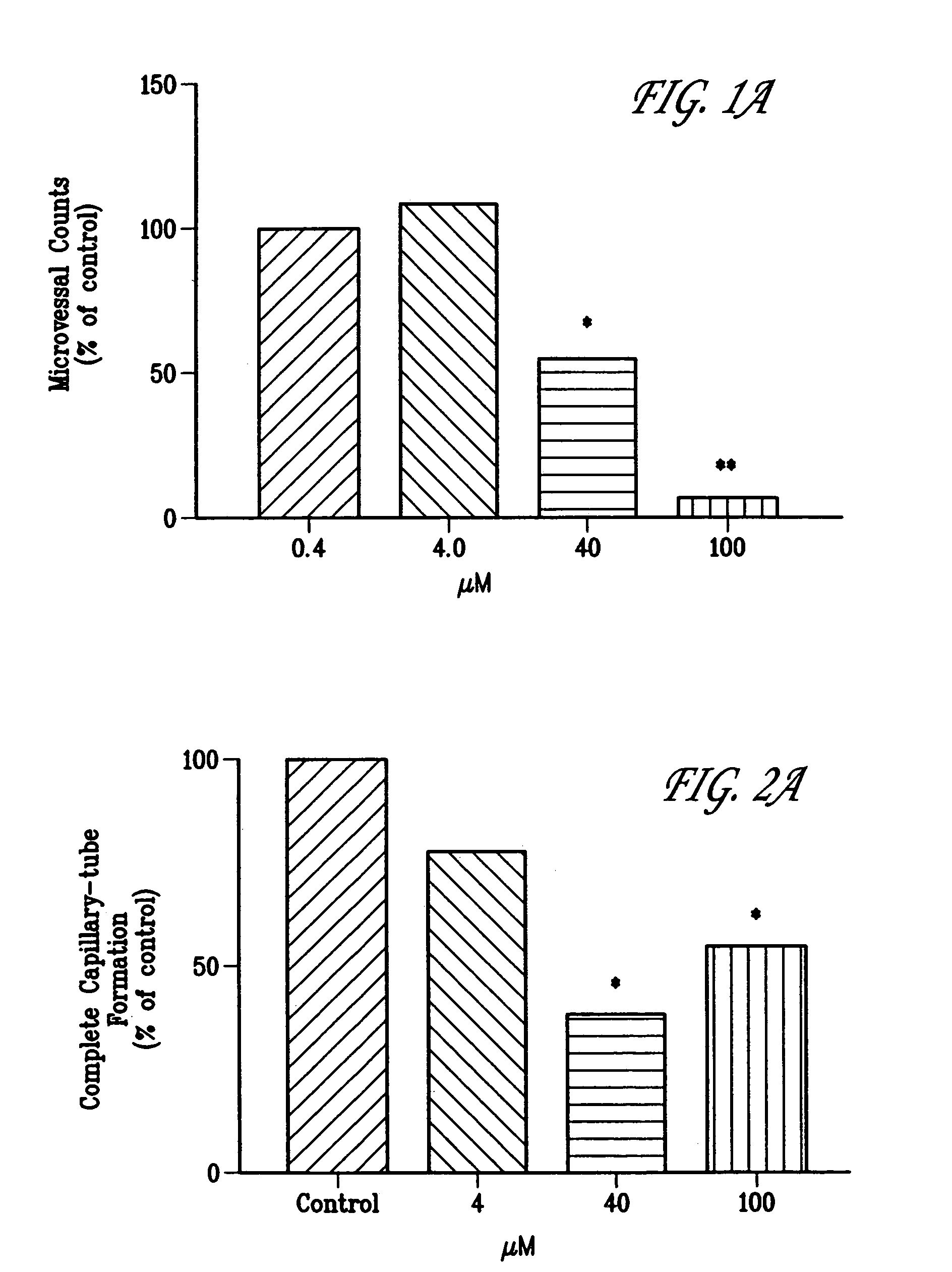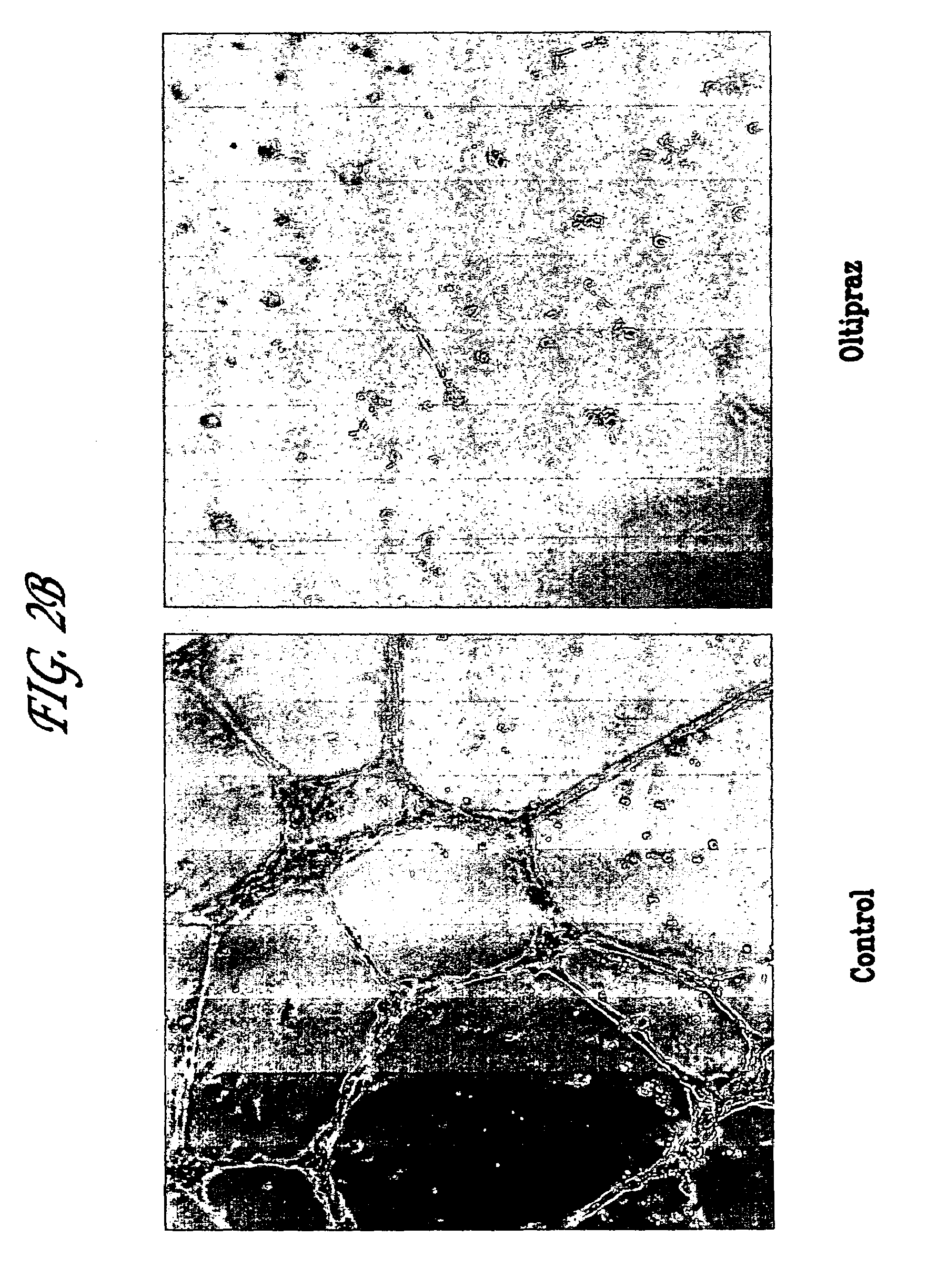Methods for inhibiting angiogenesis
a technology of angiogenesis and angiogenesis, which is applied in the direction of biocide, drug composition, cardiovascular disorder, etc., can solve the problems of limited success to date and little if any evidence to sugges
- Summary
- Abstract
- Description
- Claims
- Application Information
AI Technical Summary
Problems solved by technology
Method used
Image
Examples
example 1
Anti-angiogenic Activity of Oltipraz on Microvessel Growth in Rat Aortic Ring Explant Cultures ex vivo.
[0107]Rat aortic ring explant cultures were prepared by a modification of protocols described previously (22–24). This ex vivo model is particularly useful to study microvessel growth, maturation, and remodeling events in the angiogenic process and the role of endothelial cell-adventitial cell interactions in these events (22–24). Briefly, male Sprague-Dawley rats (250 g) were euthanized with CO2 and their thoracic aortas were removed aseptically and carefully to avoid damaging the vessel wall. Aortas were rinsed in serum-free EBM (Clonetics), the surrounding adventitia removed surgically, and the cleaned vessel cut into 1–2 mm concentric rings. Each ring was embedded in freshly prepared rat tail collagen as detailed (24). Following gelation for 30 min at 37° C., collagen gel cultures were transferred to 16 mm wells (4-well NUNC dishes), each containing 0.5 ml of serum-free EBM. Ol...
example 2
Anti-angiogenic Activity of Oltipraz on Capillary Tube Formation by HUVECs in vitro.
[0109]In order to evaluate the potential anti-angiogenic activity of Oltipraz in a bioassay utilizing human endothelial cells, its ability to inhibit capillary tube formation by HUVECs grown on a Matrigel synthetic extracellular matrix was examined in vitro by a modification of methods described previously (21, 22). This assay models several critical steps in the earlier phases of an in vivo angiogenic response, including endothelial cell adhesion, basement membrane proteolysis, and the proliferation, migration, and differentiation of endothelial cells into a network of capillary tube-like structures—events preceding the formation of new functional microvessels in vivo (21, 22).
[0110]Forty-eight-well Nunclon plates (Fisher Scientific, Malvern, Pa.) were coated with Matrigel (Collaborative Research, Bedford, Mass.) (200 μl at 10 mg / ml) and incubated at 37° C. for 30 min to promote gelling. HUVECs were...
example 3
In vivo Anti-angiogenic Activity of Orally Administered Oltipraz in the PAEC-Matrigel Plug Assay in Nude Mice.
[0112]One approach to the study of angiogenesis in vivo has been the evaluation of neovascularization into biocompatible polymer matrices containing known angiogenic factor(s) or cell types implanted subcutaneously in vivo. This approach has provided a rapid and quantitative means to evaluate the dose-related induction or inhibition of angiogenesis by a variety of stimuli relative to untreated control matrix implants (25, 27, 29). The in vivo inhibition of angiogenesis by orally administered Oltipraz was evaluated in a modified polymer implant assay utilizing PAEC and VEGF in Matrigel injected subcutaneously into athymic nude mice.
[0113]The Matrigel plug implantation assay used in these studies was a modification of that described by Passaniti et al. (25). Briefly, PAEC were grown to confluency in Ham's F-12 medium supplemented with 10% fetal bovine serum. Cells were used be...
PUM
| Property | Measurement | Unit |
|---|---|---|
| concentration | aaaaa | aaaaa |
| size | aaaaa | aaaaa |
| stereoisomer | aaaaa | aaaaa |
Abstract
Description
Claims
Application Information
 Login to View More
Login to View More - R&D
- Intellectual Property
- Life Sciences
- Materials
- Tech Scout
- Unparalleled Data Quality
- Higher Quality Content
- 60% Fewer Hallucinations
Browse by: Latest US Patents, China's latest patents, Technical Efficacy Thesaurus, Application Domain, Technology Topic, Popular Technical Reports.
© 2025 PatSnap. All rights reserved.Legal|Privacy policy|Modern Slavery Act Transparency Statement|Sitemap|About US| Contact US: help@patsnap.com



